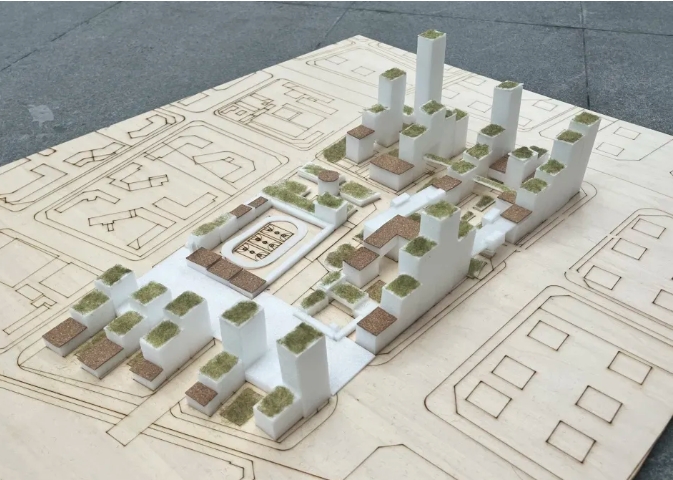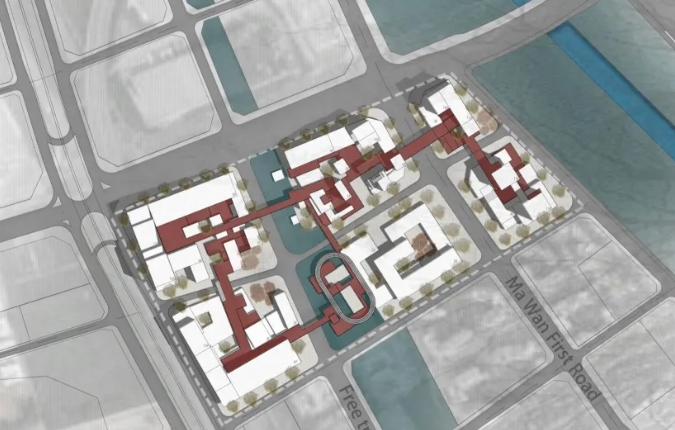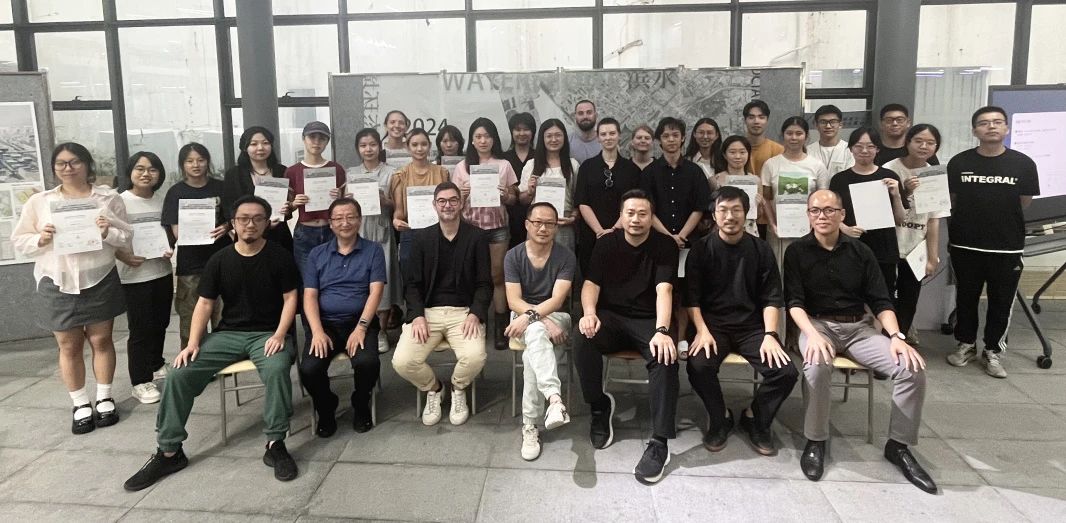建筑与城市国际联合设计工作坊课程基于“中奥四校联合城市设计营”的联合教学协议开展,由维也纳理工大学,东南大学、同济大学和深圳大学联合创办发起于 2002 年。 城市设计营一年一度,由各个学校轮流作为东道主来选题和组织。设计营关注的焦点 是中国与奥地利两国近十年来共同面临的城市问题,通过 10 多天的短期交流与设计, 汇聚四校学生与老师的创意与努力,形成最终课程设计研究成果。
The International Joint Design Workshop on Architecture and Urbanism is conducted under the "Sino-Austrian Joint Urban Design Camp" agreement, established by the Vienna University of Technology, Southeast University, Tongji University, and Shenzhen University in 2002. The Urban Design Camp is an annual event, with each participating university taking turns to host and organize the topic. The camp focuses on urban issues that China and Austria have commonly faced over the past decade. Through more than 10 days of intensive exchange and design, the workshop harnesses the creativity and efforts of students and professors from all four universities to produce final design research outcomes.
回顾深圳的发展可以发现,深圳一直在往多心多轴的组团网络型城市发展。从一开始的罗湖中心, 到后来的福田中心,而深圳西部发展城市新中心的趋势也日益明显。深圳市新版总体 规提出建设大前海中心与福田-罗湖中心,两心功能各有侧重,形成深圳全域两大发展核心。其中,前海中心即为城市双中心之一,承担城市和区域的高端服务功能。 深圳前海中心由宝安中心区、桂湾片区、前湾片区、妈湾片区四大功能片区组成。其中妈湾片区:重点发展现代物流、航运服务、供应链管理、创新金融及其他专业服务业等产业,打造具备区域生产组织中枢和国际供应链管理中心功能的保税港片区。自2012开始,前海的规划发展已进行了10多年。在累积一定的经验和根据社会、市场环境情况,妈湾片区的城市设计目标变得更为明确,拟打造为前海深港国际服务城。
Reviewing Shenzhen's development reveals a consistent trend towards evolving into a multi-core, multi-axis networked city. From the initial focus on the Luohu center to the subsequent development of the Futian center, the emergence of a new urban center in the western part of Shenzhen has become increasingly evident. The latest master plan for Shenzhen proposes the construction of the Greater Qianhai Center alongside the Futian Ruohu Center, with each serving distinct functions, thus forming two major development cores for the entire city. Qianhai Center, one of the city's dual centers, is tasked with providing high-end urban and regional services. The Qianhai Center comprises four major functional areas: the Bao'an Central District, Guiwan District, Qianwan District, and Mawan District. Specifically, the Mawan District is focused on the development of modern logistics, shipping services, supply chain management, innovative finance, and other professional service industries. It aims to establish itself as a bonded port area functioning as a central hub for regional production organization and international supply chain management. Since the planning of Qianhai began in 2012, over a decade of development has ensued, accumulating substantial experience and insight into the socio-economic and market conditions. As a result, the urban design goals for the Mawan District have become more defined, with an ambition to transform it into the Qianhai Shenzhen-Hong Kong International Service City.
各组作品/The works of each group

设计说明:
此次深圳前海滨水生态社区设计工作坊基地在深圳前海妈湾片区十五单元02、03街坊,基地南北面为综合居住区,西侧为学校,东侧为景观河道。基地周边交通系统发达,四周被道路包围。基地现为为建设开发阶段。
设计呈现:第一步,依据生态绿廊的骨架,确定地块的绿化休闲轴线,串联多个特色鲜明,景观丰富的公园及广场。第二步,由于东侧河道区域景观优美安静。西北角02-01地块紧邻城市主干道,交通便利,人流密集,故将办公区与居住区功能调换,即东侧为生态居住区,西侧为智慧办公区。第四步,依据妈湾规划的港式人文生活城区,将这条街打造为文化艺术商业街。置入小体量底层建筑,丰富立面造型。
The Shenzhen waterfront water ecological Community design workshop is based in Shenzhen Qianhai Mawan District, Unit 15, Block 02, 03. The north and south sides of the base are comprehensive residential areas, the west side is a school, and the east side is a landscape river. The traffic system around the base is well developed and surrounded by roads. The base is currently under construction and development.
Design appearance: The first step is to determine the greening and leisure axis of the plot according to the framework of the ecological green corridor, connecting multiple parks and squares with distinctive features and rich landscapes. The second step, because of the beautiful and quiet landscape in the east river area. Plot 02-01 in the northwest corner is close to the main road of the city, with convenient transportation and dense population, so the function of the office area and the residential area is switched, that is, the east side is the ecological residential area, and the west side is the smart office area. The fourth step is to build this street into a commercial street of culture and art according to the Hong Kong-style humanistic life urban area planned by Ma Wan. Put into the small volume of the ground building, enrich the facade modeling.


设计说明:
以“生长与连接”为主概念,期望在四校联合工作坊的“前海滨水生态社区”设计工作中创造一个为不同类型的人群提供一个共同生活、互相沟通的有机社区。
我们讨论了6个地块中各功能单元的种种组织形式,最终决定确立妈湾地铁站-滨水空间为该城市街区的第一联系层级,在六个形态、功能各异的街区间建立第二联系层级,并在不同居住单元之间建立第三联系层级。我们从城市尺度出发,根据周边环境背景,确立了三个不同社区的不同表情特征(运动/艺术文化/休闲),并对滨水开放空间、滨水商业区、社区学校做了面向城市居民的公共化处理。
我们同样在居住商业综合建筑上进行了类型学的迭代研究,并进行了社会学、环境心理学层面的调查,最终得到了延续城市绿廊肌理且同时能解决居住密度问题的一种创新的住宅类型。
在社区形态上我们延续了有机联系的概念,选用了自然的曲线语言。最终成果模型如石笋一般塔楼林立,社区绿化覆盖率高、居住环境生态且自然。每一栋塔楼都有面向滨水空间的景观面,这符合我们对于前海滨水生态社区最初的想象。
With the main concept of "growth and connection", it is expected to create an organic community that provides different types of people to live together and communicate with each other in the design work of the "Former Waterfront Ecological Community" of the four joint workshops.
We discussed the various organizational forms of each functional unit in the six plots, and finally decided to establish the Mawan subway station-waterfront space as the first level of connection of the urban block, the second level of connection between the six blocks with different forms and functions, and the third level of connection between different residential units. Starting from the urban scale, according to the surrounding environmental background, we established the different expression characteristics (sports/art, culture/leisure) of three different communities, and made the waterfront open space, waterfront commercial area, and community school publicized for urban residents.
We also carried out iterative research on typology in residential and commercial complexes, and conducted sociological and environmental psychology investigations, and finally obtained an innovative residential type that continues the texture of urban green corridors and can solve the problem of residential density at the same time.
In terms of community form, we continue the concept of organic connection and choose the language of natural curves. The final model is like a stalagmite, with a forest of towers, a high green coverage rate in the community, and an ecological and natural living environment. Each tower has a landscaped façade facing the waterfront, which is in line with our original vision of a former waterfront ecological community.


设计说明:
我们的设计主题是LEGO,通过将乐高体块作为基本模数,利用体块堆叠形成错落有致的山谷式空间,构建一个属于所有居民的活力家园。
在规划中,我们对部分开发量和功能分区进行了优化调整。为了最大限度地利用东侧河边的优美自然环境,我们将部分河滨的开发量转移至西侧。同时,在西侧布置高层建筑,有效阻隔高架桥带 来的噪音污染,提升居住环境的舒适度。通过土地混合利用的开发模式,我们设计了底层商业、办公,和上层居住的社区模式,创造出充满多样性与活力的生活空间。在建筑设计上,通过营造退台的建筑形式,提供开放的公共活动空间,并通过楼宇间的连廊加强联系。为了保障功能互不干扰,商业与办公、居住之间的连廊在垂直空间中相互独立。
结合上位规划中的绿轴概念,我们将场地的中部设计为开放的公共活动空间,包含南侧的入口广场和中部的活动中心。通过微地形设计与覆土建筑的运用,我们有效减弱了公共服务设施的体量感,形成了一条完整的活动轴线。同时,东西向的活动轴线将场地东侧的河畔绿地自然引入场地内部,并与学校、幼儿园等公共服务设施相连接,实现了绿色空间的延伸和设施共享的目标。
我们的设计不仅注重环境与建筑的融合,更希望通过多样化的功能布局和空间设计,为居民提供一个充满活力、绿色和舒适的居住社区,成为城市中的一道独特风景线。
Our design theme is LEGO, using LEGO blocks as the basic modulus and stacking them to form a patchwork valley-like space to create a vibrant home for all residents.
In the planning, we have optimized and adjusted some development volumes and functional partitions. In order to make the most of the beautiful natural environment along the east side of the river, we have shifted part of the development of the riverside to the west side. At the same time, high-rise buildings are arranged on the west side to effectively block the noise pollution brought by the viaduct and improve the comfort of the living environment. Through a mixed-use development model, we have designed a community model of commercial, office, and residential on the ground floor to create a diverse and vibrant living space. In terms of architectural design, it provides open public activity spaces by creating a setback architectural form, and strengthens the connection through corridors between buildings. In order to ensure that the functions do not interfere with each other, the corridors between the commercial and office and the residential are independent of each other in the vertical space.
Combined with the concept of green axis in the upper plan, we designed the middle part of the site as an open public event space, including the entrance plaza on the south side and the activity center in the middle. Through the use of micro-terrain design and earth-covered buildings, we effectively reduce the sense of volume of public service facilities and form a complete axis of activity. At the same time, the east-west activity axis naturally introduces the riverside green space on the east side of the site into the site, and connects it with public service facilities such as schools and kindergartens, achieving the goal of extending green space and sharing facilities.
Our design not only focuses on the integration of environment and architecture, but also hopes to provide residents with a vibrant, green and comfortable living community through diversified functional layout and space design, and become a unique landscape in the city.


设计说明:
该项目从场地当前状况出发,通过深入分析周边的交通系统、文化设施和景观方向,充分考虑马湾总体规划的指导思想。我们采用了两条主要轴线和多路径连接的策略,对核心建筑进行了精心的布局。这样的设计不仅使得大型商业设施和住宅区得到了合理的规划,同时也巧妙地将小型的文化和商业区块融入其中,形成了以人尺度为基础的舒适慢行区块。
为了进一步激发社区的活力,我们通过设计小方块形式的多功能体块,这些体块不仅在视觉上形成了丰富的层次感,而且在功能上也实现了多样性的融合。这些体块可以是小型的商业空间、文化展览区或者社区服务点,它们的存在使得社区居民的生活更加便捷,同时也为社区带来了更多的活力和生机。
此外,我们还致力于打造地下的商业系统,这一系统不仅能够提供额外的商业空间,还能够有效地连接地铁线路,为未来的商业发展提供了无限的可能性。通过这样的设计,我们不仅提升了社区的商业价值,也为居民提供了更加便捷的交通方式,使得社区的发展更加具有可持续性。
总的来说,这个项目的设计充分考虑了人与环境的和谐共生,通过多功能体块的设计和地下商业系统的打造,不仅提升了社区的居住品质,也为社区的经济发展注入了新的活力。我们相信,这样的设计将会为社区居民带来更加美好的生活体验。
The project begins with the current state of the site, conducting an in-depth analysis of the surrounding transportation systems, cultural facilities, and landscape orientations, all while taking into account the overall planning of Mawan. We have meticulously planned the core architecture using two main axes and a multi-path connection strategy. This design not only ensures the rational layout of large-scale commercial facilities and residential areas but also ingeniously integrates smaller cultural and commercial blocks, creating comfortable pedestrian zones based on a human scale.
To further stimulate the community's vitality, we have designed small block-shaped multifunctional blocks. These blocks not only create a visually rich sense of hierarchy but also achieve a diverse integration of functions. They can serve as small commercial spaces, cultural exhibition areas, or community service points, making life more convenient for residents and bringing more vibrancy and energy to the community.
In addition, we are committed to creating an underground commercial system that not only provides additional commercial space but also effectively connects to subway lines, offering endless possibilities for future business development. With this design, we have not only enhanced the commercial value of the community but also provided residents with a more convenient mode of transportation, making the community's development more sustainable.
Overall, the design of this project fully considers the harmonious coexistence of people and the environment. Through the design of multifunctional blocks and the creation of an underground commercial system, we have not only improved the quality of community living but also injected new vitality into the community's economic development. We believe that this design will bring a better life experience to community residents.


设计说明:
本设计概念从城中村中一种自由搭建的自发性活动出发,想要在地块中让人们自由的使用地块中的每一个部分。但以自发性为主导的城市规划需要时间的积累和历史性的沉淀,我们自发性,自组织的空间制定了规则:当不同功能空间碰撞时,不同空间中不同的人群相遇。我们给出一个未定义的空间去让该空间发生“自组织”的活动,去让各司其职的人们回溯日常。在整个场地中,我们以外高内底的形式去布置场地块中的建筑,其组织方式采用了“C”的形式,围合出等级不同的院落与广场。在生态方面,我们围绕穿过场地的城市绿带建立生态廊桥,将生态从绿带引入场地各个部分。同时,我们保证景观的需求,在建筑体量上适当挖洞和退让,让出了场地右侧的河流景观以及各个场地之间的视线联系。
The design concept starts from a kind of spontaneous activity in the urban village, and wants to allow people to use every part of the plot freely in the plot. However, urban planning dominated by spontaneity requires the accumulation of time and historical precipitation, and our spontaneous and self-organizing space sets the rules: when different functional spaces collide, different groups of people in different spaces meet. We give an undefined space for "self-organizing" activities to take place in that space, and for people who are doing their jobs to reminisce about their daily lives. Throughout the site, we arranged the buildings in the site in the form of an outer-high insole, which was organized in the form of a "C", enclosing courtyards and squares of different levels. In terms of ecology, we have built an ecological corridor around the urban green belt that passes through the site, introducing ecology from the green belt to all parts of the site. At the same time, we ensure the needs of the landscape, and appropriately dig holes and retreats in the building massing, giving way to the river landscape on the right side of the site and the line of sight between the various sites.


设计说明:
方案位于深圳市妈湾片区,基于其独特的地理位置和上位规划进行概念和方案的生成。概念为一个“三明治”,希望用一个整体性的巨构建筑来解决场地问题。下层为街坊布局,类似于老深圳的街巷尺度,亲密自然生动,中间层为一个地毯,覆盖在街坊的上方,其上开设裂隙和洞口用于采光。整体地毯进行切分,沿城市绿带方向设计高差,使人通过巨大的地景平台缓缓走上,巨大面积的地毯被上层水平向住区分隔成一个个独立小空间,用于承载各种公共活动。住区采取水平摩天楼的设计方式,总体为呼应东边重要绿带水体而向东方向打开,同时为了强化地毯的中心性特点,设计小的“分叉“,以不同角度指向中心绿地,并围合出不同尺度,不同界面性质的公共空间。
The project is located in the Mawan area of Shenzhen, with the concept and scheme generated based on its unique geographical location and upper-level planning. The concept is a "sandwich", aiming to solve the site problems with an overall large-scale architectural structure. The lower level features an alley layout reminiscent of the old Shenzhen street scale, intimate, natural, and vivid. The middle layer is like a "carpet" covering the alleys above, with fissures and openings for lighting. The overall carpet is divided, with a design that incorporates changes in elevation along the direction of the urban green belt, allowing people to gently walk up through the large landscape platform. The huge carpet area is separated into individual small spaces by the horizontal residential areas above, which are used to host various public activities. The residential area adopts a horizontal skyscraper design, opening up towards the east in response to the important green belt and water body, while also designing small "forks" to point towards the central green space from different angles, enclosing public spaces of varying sizes and interface characteristics to enhance the centrality of the carpet.

评图与答辩/Seminars and Reviews

答辩现场
Defense Session

终期评图合影
Group photo of the final review
 版权所有©深圳大学 粤ICP备11018045号-7
版权所有©深圳大学 粤ICP备11018045号-7






 Sitemap
Sitemap




